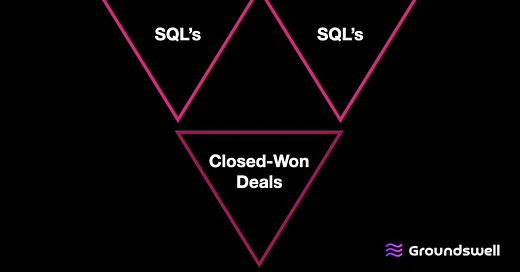What is “product-led sales?”
Product-Led Growth (PLG) is getting a lot of attention lately.
And it just so happens that I was in the right place at the right time last year to be consulting for Zoom, and ended up getting the opportunity to join them full-time for all of 2021. I was able to observe from the front lines what a best-in-class Product-Led Growth software company looks like. And if I’m being honest, it looked really different than what I thought it would look like from the outside. The product did not sell itself, even though you can, technically, sign up for Zoom, start using it, and even upgrade to a paid plan with more features. The reality is, Zoom has 2,000+ salespeople that support their go-to-market motion. PLG is not magic. But it is a dark art.
Layering salespeople on top of a PLG motion is complex and nuanced. It requires the utmost degree of both science and art.
This newsletter is created to tell the stories of people within companies who are actually doing product-led growth. And more specifically, we’ll focus on the sales side of the go-to-market motion, within PLG companies — let’s double click into this sentence. Because when you hear the phrase “Product-Led Growth” (PLG), you may think that this means no salespeople. I’m here to tell you, it doesn’t. We’ll define the following as “product-led sales:”
A company with both a bottom-up motion (“Get Started” button on the home page—that actually works) and a top-down motion (a sales team—which usually means an ACV>$10K).
If this is your first time reading Product-Led Sales, join the smartest sales leaders and sales reps at product-led sales companies to get the latest posts delivered directly into your inbox.
Sales Automation Tools ≠ Replacing Salespeople
When sales engagement platforms (ie: Outreach, SalesLoft, etc.) first came out ten years ago, salespeople were never threatened. Sales engagement platforms made a seller’s job easier. They allow/ed you to scale your efforts through automation. They allow/ed you to see what workflows worked, and what workflows didn’t work. They gave sellers a tool that they previously did not have access to.
I would argue that PLG does the same exact thing for sellers—it’s a new arrow in a seller’s quiver, to be able to engage with potential buyers.
Buyers are now able to see a little bit of your product before you interact with them. This is great news for sellers. Why? Because these are “hot leads!” This is a new type of “hand-raise” that has never existed before. So sellers should be stoked about this new revolution of PLG, not threatened by it.
Another analogy that could be made is conversational intelligence (ie: Drift, Intercom, etc.). Again, a pessimistic way to look at conversational intelligence tools is that they threaten salespeople’s livelihood by automating what a human (seller) used to do manually. But, the smartest sellers and sales leaders embraced conversational intelligence. It was a new channel, a new funnel, and a better way for buyers to engage. Simply a new option. Net-sum.
PLG, again, is the same. Embrace the new channel and you will win. Ignore it, and you will lose.
PLG is your friend
If you're lucky enough to be a seller at a company product-led company, be thankful.
PLG is not replacing you.
In fact, you're lucky in that - you get to talk with people who have already engaged with your product, and therefore, are able to have a much higher-level conversation.
But know that because of this new reality, there is much wider variance in a prospect's buying journey.
As a seller at a PLG company, you have to be very observant in the nuances of how a buyer wants to engage with you, and when.
Bottom-up (PLG) + Top-down (Salespeople) = 💜
Adding yet another funnel into the revenue machine adds complexity. But it is here to stay.
You can simply look at PQLs (Product Qualified Leads) as another source in the overall funnel in the revenue machine. Sellers need to learn how to embrace this new funnel.
It does add complexity and nuance to the selling process. Learning how to navigate and operationalize that complexity can be difficult. This is especially important for the person/team who owns this new motion — which, by the way, will likely require resources from Product, Marketing, Sales, Success, Growth, Ops, and Enablement. It’s a lot, I know. Deep breaths.
The good news: that’s what this newsletter is here to help us learn together.
Conclusion
I’m a sales guy. That’s where I cut my teeth and I’ll always be a sales guy, albeit an introverted one. But as a sales guy, I assure you PLG is here to stay.
So, we as salespeople, and sales leaders, need to learn how to embrace this shift. It’s better for the buyer, and I believe it is better for sellers as well.
I’m going to be interviewing sales leaders and sales reps who are on the front lines at the best product-led sales companies in the world. Join me in learning with them.
Subscribe + Share 💜
The first guest spotlight for Product-Led Sales will be Katie Jane Bailey, who is a top Account Executive at Figma. Figma is a darling when it comes to product-led growth + sales. And not many people publicly know about Katie Jane (yet), so I’m genuinely excited to shine a light on how badass she is.
This newsletter will be the stories from people within companies who are actually doing product-led sales.
Subscribe and share this with friends who are in sales at product-led sales companies.
See y’all soon for Episode 1 of Product-Led Sales!
-Brendan J Short




